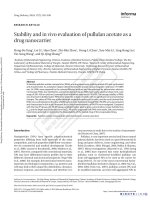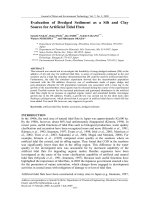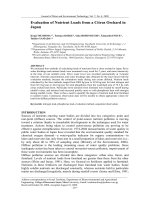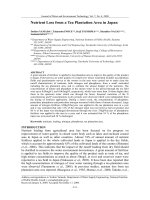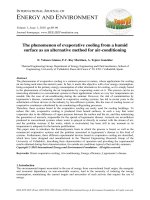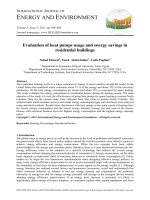Evaluation of Nutrient Loads from a Citrus Orchard in Japan
Bạn đang xem bản rút gọn của tài liệu. Xem và tải ngay bản đầy đủ của tài liệu tại đây (262.53 KB, 10 trang )
Journal of Water and Environment Technology, Vol. 7, No. 4, 2009
Address correspondence to Kouji Tsushima, Department of Bioenvironmental and Agricultural
Engineering, College of Bioresource Sience, Nihon University, Email:
Received October 30, 2008, Accepted August 10, 2009.
- 267 -
Evaluation of Nutrient Loads from a Citrus Orchard in
Japan
Kouji TSUSHIMA*
,†
, Testsuya KOIKE*, Yoko HORINOUCHI*, Takanobu INOUE*,
Toshiro YAMADA**
*Department of Architecture and Civil Engineering, Toyohashi University of Technology, 1-1
Hibarigaoka, Tempaku-cho, Toyohashi, Aichi 441-8580 Japan
**Department of Water Supply Engineering, National Institute of Public Health, 2-3-6 Minami,
Wako, Saitama 351-0197 Japan
†Present address: Department of Bioenvironmental and Agricultural Engineering, College of
Bioresource Sience, Nihon University, 1866 Kameino, Fujisawa, Kanagawa 252-8510 Japan
ABSTRACT
We estimated four methods of calculating loads of nutrients from a citrus orchard in Japan. River
water discharge and nutrient loads were examined every week for 2 years and more intensively
at the time of one rainfall event. River water level was recorded automatically at 5-minute
intervals. Nutrient concentrations and water discharge data obtained for the load varied with the
evaluation methods, because the estimations made during rain events differed. Nutrient loads
calculated by the four methods ranged from 2004 kg/year to 4194 kg/year for total nitrogen and
from 30.3 kg/year to 44.6 kg/year for total phosphorus from the watershed area of 78.3 ha with
citrus orchard and forest. Particulate form nutrients from farmland were loaded by runoff during
rainfall events, and nutrient load increased quickly more so with phosphorus than with nitrogen
during rainfall events. There is thus a need to quantify the degree of nutrient load from farmland
in rainfall events. Continuous observation data will be needed to obtain appropriate values for
load from diffuse pollution sources.
Keywords: nitrogen load, phosphorus load, evaluation method, sequential observation.
INTRODUCTION
Sources of nutrients entering water bodies are divided into two categories: point and
non-point (diffuse) sources. The control of point-source nutrient pollution is moving
toward a solution thanks to remarkable developments in the techniques used for water
treatment. Actions being taken to control point-source pollution are proving to be
effective against eutrophication. However, 1974-2004 measurements of water quality in
public water bodies in Japan have revealed that the environmental quality standard for
chemical oxygen demand—a water-quality indicator for organic contamination—in
lakes and reservoirs has only been met in a small proportion of lakes and reservoirs (i.e.,
by only about 40 to 50% of sampling sites) (Ministry of the Environment, 2006).
Diffuse pollution is the leading remaining cause of water quality problems. Since
inadequate action has been taken to control non-point-source pollution, improvement of
these water environments has been incomplete.
Diffuse pollution sources are divided into three categories: urban area, forest, and
farmland. Levels of nutrient loads from farmland are greater than those from the other
sources (Ebise and Inoue, 1991). Here, we focused on fertilizers applied in farmland.
Nutrients in these fertilizers are discharged from farmland into water bodies. Some
highly soluble nutrients are discharged constantly, whereas nutrients held in particulate
matter are discharged irregularly, mainly during rainfall events (Inoue and Ebise, 1991;
Journal of Water and Environment Technology, Vol. 7, No. 4, 2009
- 268 -
Inoue et al., 2003; Yamada and Inoue, 2005).
In the present study, we aimed to identify the characteristics of nitrogen and phosphorus
loads from a Japanese citrus orchard (a type of farming enterprise that usually needs
intensive application of nutrients), and to compare the loads derived from the four
methods.
MATERIALS AND METHODS
Study Area
Study area including in a citrus orchard is located in Shizuoka Prefecture, in central
Japan (Fig. 1). This area is famous in Japan for the production of high quality mandarin
oranges. Study area is a region where forest had been changed to orchard, and the land
use is simply composed of forest and orchard. The study site downstream of the orchard
receives the orchard discharge; the area of the watershed at the downstream site is 78.3
ha. The citrus orchard occupies 30.4 ha (39%) of the watershed, the remainder being
forest. The study site upstream of the orchard is a control site to the downstream site.
The upstream site has a watershed area of 6.7 ha, which is covered with forest. It is
assumed that the forest is almost uniformity in the area.
Fig. 1 - Study Area. The brown and green lines delineate the watershed of the
downstream (○) and upstream (□) sites, respectively. The upstream site is located on a
branch river. The watershed of the upstream site is a watershed covered with forest.
Sample Collection
Water samples were collected at the upstream and downstream sites every week from
November 2005 to October 2007. Intensive sampling was performed at the downstream
site on 8 and 9 October 2007 during a rainfall event. The total rainfall during the
sampling period was 16.5 mm (on the morning of 8 October), and water samples were
collected 15 times from 9:00 on 8 October to 11:00 on 9 October.
Observation methods
The water levels at the downstream site were recorded automatically at 5-min intervals
during the research period. Water discharges were measured with an electromagnetic
current meter at the downstream site when the water samples were collected.
Continuous at 5-min intervals water discharge data at the downstream site were
Japan
Downstream site
Upstream site
0
500
1000m
Journal of Water and Environment Technology, Vol. 7, No. 4, 2009
- 269 -
calculated using the relationship between the measured discharges with the current
meter and the automatically measured water levels. The relationships between the
measured discharges (Q) and the water levels (H) on the observation show in Fig. 2.
This H-Q relationship was approximated by two quadratic equations as follows;
( )
mm5.981009.41092.1
326
≤×+×=
−−
HHQ (1)
( )
mm5.981092.41042.7
226
>×−×=
−−
HHQ (2)
where Q is water discharge (m
3
/s) at the sampling site, H is water level (mm) at the site.
0
0.1
0.2
0.3
0.4
0 50 100 150 200 250
Water level (mm)
Water discharge (m
3
/s)
Fig. 2 - The measured discharge versus the automatically measured water level at the
observation. The gray curve lines show the H-Q quadratic equations.
Water discharge at the upstream site was compared with that at the downstream site, and
each was determined in proportion to the watershed area. Laboratory analyses of the
collected water samples included concentrations of total nitrogen (TN) and total
phosphorus (TP), which were determined by standard methods with colorimeter.
Suspended solids (SS) were collected on a pre-combusted Whatman GF/F glass-fibre
filter (mean pore size: 0.7 µm). The concentrations of SS were determined from the
differences in the dry weights of the filters before and after filtration.
Estimations in 4 Cases of Nutrient Loads
We assumed that the nutrient concentrations and water discharges were constant over a
period of half the observation interval (half of a week before and after the observation),
because our evaluation was made only by intermittent observation. Nutrient load was
obtained by multiplying nutrient concentration by water discharge during the same
period (Case 1).
In the next case (Case 2)—evaluation from weekly researched concentrations and
automatically recorded water levels—we obtained continuous water discharge data from
the automatic water level records. As in Case 1, we had to assume that the
concentrations were constant during periods for which we lacked continuous data.
However the continuous water discharge data calculated from the automatically
measured water levels were used for Case 2. The water discharge calculations of Case 2,
unlike those of Case 1, included the contribution of rainfall events.
Daily nutrient loads from farmland can change not only seasonally and with
Journal of Water and Environment Technology, Vol. 7, No. 4, 2009
- 270 -
anthropogenic activity, but also during rainfall events. Diffuse pollution loads from
farmland can accelerate dramatically during even short rainfall events (e.g., Ebise and
Inoue, 1991; Inoue and Ebise, 1991; Inoue et al., 2003), though observations and
evaluation of water discharge and nutrient concentrations at these times are difficult.
Loads from diffuse pollution sources cannot be calculated accurately by weekly
research, which is normally researched at the time when the water discharge was almost
same as the base flow. We therefore need a way of accurately quantifying nutrient load
from farmland during rainfall events. We can obtain sequential nutrient load data by
empirical estimations made from sequential water discharge data (i.e., nutrient load is
predictable from water discharge). The relationship between water discharge and
nutrient load can be analyzed by the regression model,
n
QaL = (3)
where L is nutrient load at the sampling site, Q is water discharge at the site, and a and n
are coefficients. This equation is called the L-Q equation model (e.g., Komai et al.,
2003; Kunimatsu et al., 2006) and shows the relationships between nutrient load (L) and
water discharge (Q). We decided the optimum coefficients (a and n) of two sets (Cases 3
and 4) by applying the least-squares method to antilogarithmic and logarithmic
regression curves. The Case 3 evaluation was made on an antilogarithm scale, and Case
4 used a logarithmic scale. Kawara et al. (1984) showed utility to which the optimum
coefficients (a and n) of a L-Q equation model were decided by applying the
least-squares method to logarithmic regression curve. This decision method decreases
the influence of small number of high load values upon the coefficients.
RESULTS
Nutrient Concentrations
TN and TP concentrations at the upstream site were low, and those at the downstream
site were high (Figs 3 and 4), because nitrogen and phosphorus were discharged from
the citrus orchard. There was no seasonal trend in total nitrogen concentration, which
was about 3-4 mg/L downstream and 0.5 mg/L upstream.
0
2
4
6
8
10
Feb May Aug Nov Feb May Aug Nov
Research period (2006-2007)
TN (mgN/L)
0
100
200
300
400
500
Rain (mm/day)
Upstream site
Downstream site
Rain
Fig. 3 - Total nitrogen (TN) concentrations at research sites every week. Rain data
quoted daily precipitation in the Automated Meteorological Data Acquisition System of
Mikkabi observation station by Japan Meteorological Agency (2008).
Journal of Water and Environment Technology, Vol. 7, No. 4, 2009
- 271 -
0
0.1
0.2
0.3
0.4
FebMayAugNovFebMayAugNov
Research period (2006-2007)
TP (mgP/L)
0
100
200
300
400
500
Rain (mm/day)
Upstream site
Downstream site
Rain
Fig. 4 - Total phosphorus (TP) concentrations at research sites every week. Rain data
quoted daily precipitation in the Automated Meteorological Data Acquisition System of
Mikkabi observation station by Japan Meteorological Agency (2008).
Load Estimations
Load evaluation of Case 1 was calculated by water discharge and nutrient load from our
only weekly research data (Table 1). In the Case 2 evaluation, only the water discharge
calculations considered the contribution of all rainfall events. The results of our
evaluation by weekly field research and the automatic water level records showed that
the Case 2 evaluation gave a higher discharge than in Case 1. Kunimatsu et al. (2006)
calculated cv (coefficient of variation) values of the annual loads in Mano River
(watershed area of 16.4 km
2
), under various conditions of observation frequency (from
every day to every 30 days) by the same method as Case 2 of our study. Kunimatsu et al.
(2006) also reported the cv values of the annual loads calculated from the data of
weekly (7-days interval) observation were 0.54 for total nitrogen and 0.74 for total
phosphorus, and that of discharge was 0.23. They designated that the annual loads
calculated with Case 2 vary widely depending on only the observation frequency. The
cv values will change depending on at least the size and land use of watershed, therefore
we avoided simply referring to those values.
The sequential nutrient load data for the research period for Cases 3 and 4 were summed
and are shown in Table 1. Fitted curves of the L-Q equations were drawn for nitrogen
and phosphorus in accordance with our observations (Figs 5 and 6). The L-Q equations
estimated in Cases 3 and 4 are shown in Table 2.
Table 1 - Evaluation of nutrient loads and water discharge for each case at the
downstream site (watershed area of 78.3 ha).
1234
(kg/yr) 2004 3172 4194 3693
(kg/ha/yr) 25.6 40.5 53.6 47.2
(kg/yr) 30.3 42.7 44.6 40.7
(kg/ha/yr) 0.39 0.55 0.57 0.52
Water discharge
(10
4
m
3
/yr)
50.6 80.4 80.4 80.4
Case
TN load
TP load
